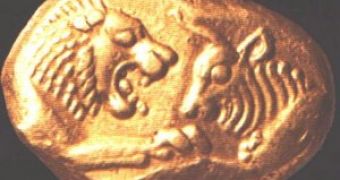When this treasure was buried, during the fifth century BC, western Turkey formed the kingdom of Lydia and its kings had the fame of being the world's richest monarchs. This was especially true for the last Lydian king, Croesus.
Herodotus wrote about Lydia, Croesus and his inexpugnable capital, Sardes, said to be polished with gold and inside whose walls 20,000 to 50,000 persons had a luxury life. Obsessed with richness, Croesus surrounded himself with countless gold objects, received as gifts, and which he offered generously. Croesus is also said to be the inventor of the coin, as we know it today.
In antiquity, debts were paid by weighing noble metal used for paying. The idea to use metal pieces to make monetary standards would have generalized in the Aegean (Greek) world during the 7th century BC, but no coins older than 645 BC have been found. The oldest coins were encountered under the foundation of the temple of Artemis, in Ephes. They are made of electrum, a natural alloy of gold and silver, and bear lion heads, the symbol of the royal emblem of the Lydian capital, Sardes.
Pure gold coins were introduced around 550 BC by Croesus. He had the idea to mark decorative motifs, animal figures and his effigy on the coins. He also ordered that their value and origin place be written on them. The king was the only guarantor of the value of the coins. Nobody could cut pieces from the coins, as the motifs stretched to their edges. A large part of the gold came from the neighboring mountains but also from the sand of the Pactol River that crossed Sardes.
Wanting to know which would be the results of a Lydian attack against Persia, Croesus went to Greece, to consult the famous Apollo's Oracle in Delphi. This is what priestess Pythia responded to Croesus' question: "When Croesus will cross the Halys River, an empire will fall." Croesus interpreted the answer in his favor and declared war against Persia. But the oracle had not specified which empire would fall.
Before receiving the help of his powerful allies, Egypt and Babylon, the armies of Cyrus sieged Sardes, crushing the Lydian armies in a fierce battle, in 546 BC. One year later, the whole Lydia was a Persian province.
Croesus died in 546, and a treasure was buried with him in his tomb. The tomb was made of stone covered by soot to reduce the effect of humidity. Turkey is full of such ancient tombs, and from time to time, earthquakes or storms reveal the site of an ancient tomb. Villagers knew how to penetrate into these tombs, and many were looted this way. In 1966, the looters of the tomb of Croesus were caught, but only half of the stolen objects were recovered by Turkish authorities.
In 1984, part of the unrecovered treasure was detected in an exhibition of the Metropolitan Museum in New York. The pieces had been achieved from various art object traders from Munchen, Berlin and Zurich.

 14 DAY TRIAL //
14 DAY TRIAL //